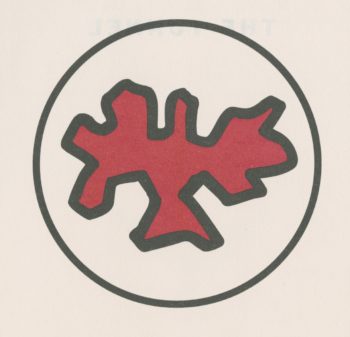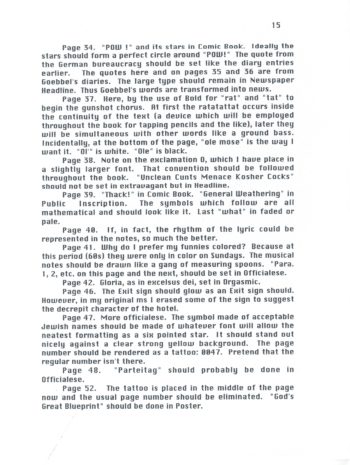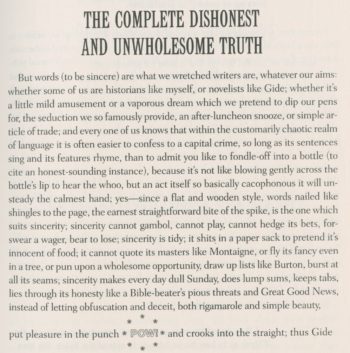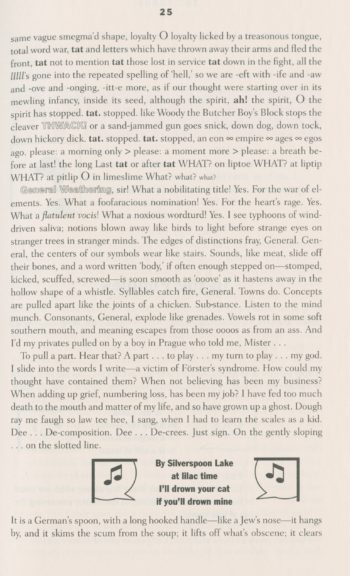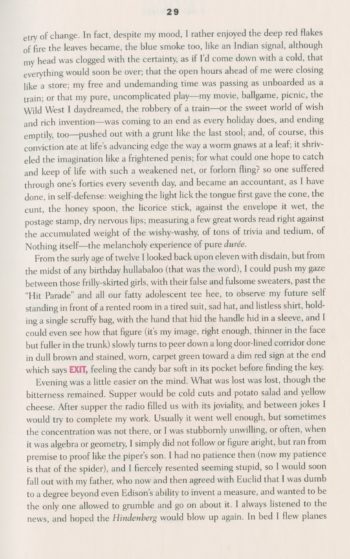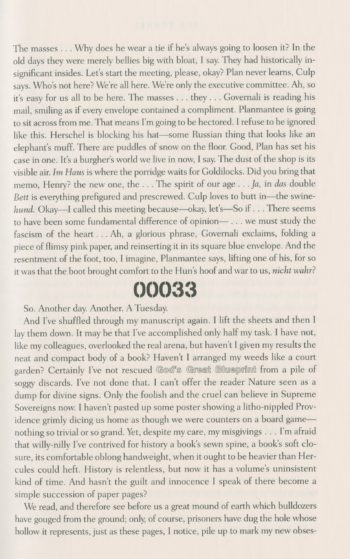
Remembering William H. Gass: Resources for Exploring a Life in Sentences – Part 4
The Washington University will host a tribute to the life and work of William H. Gass. The event will take place tomorrow, April 6, 2018 on Washington University’s Danforth campus. Manuscripts and other materials from the William H. Gass Papers will be on view in Olin Library Special Collections.
Activities start in Special Collections at 2:45 p.m., with the following speakers: Kathryn Davis, Catherine Keane, Martin Riker and Mark Rollins. From 3:15-3:45 p.m. Joel Minor will host a viewing of selected Gass manuscripts and rare books. Then, in Holmes Lounge at 4:00, Chancellor Mark Wrighton, Joy Williams, Garth Risk Hallberg, Lorin Cuoco, Matthias Goeritz and Michael Eastman will give remarks, followed by a reception at 6:00. A photograph slideshow will also be featured at Holmes, curated by Catherine Gass.
Today, to continue previewing materials we will have out from Special Collections, we take a look at Gass’s magnum opus, The Tunnel.
By the time The Tunnel was released by Knopf in 1995 William H. Gass had spent 26 years writing and perfecting its text. It is a fiction of the utmost precision, where even the wildest and most chaotic outbursts are carefully designed and controlled. But the formidably rigorous text is only half story, because the book itself, particularly in its first hardcover edition, must be one of the most carefully and specifically designed physical objects ever put out by a major publishing house. In addition to its imposing dimensions—652 pages measuring 6.25 inches by 9.25 inches wrapped in a black cover slashed with a red band housing an unsettling symbol, with its title in a monolithic font that repeats and fades its way down, or rather up, the front of the book—there is a kaleidoscope of textual effects, fonts, lineations and illustrations (in color in the first edition) that seem to make the reader constantly aware that they are reading a book, and that The Tunnel is not a book as usually understood.
In a 1994 letter to Knopf’s Vicky Wilson, sent during the copy-editing and setting of the first edition, Gass lays out in detail his vision of the ideal physical form of the book, with 20 pages of notes requesting specific considerations on almost every one of book’s more than 1000 manuscript pages ranging from the handling of concrete text passages to the treatments and fonts of individual words. Whereas in many cases typesetting might seem a matter of determining fonts, margins, line spacing, and the handling of chapter breaks, letting the text flow within these parameters, the typesetting of The Tunnel is as specific as its composition, with Gass stipulating in some cases that a particular phrase should appear unbroken on a single line, or that a certain page should end at a specific point in the text. Reading this document, and all the details it negotiates, one begins to wonder if Gass’s ideal of the book is even physically possible to make. Indeed, in a letter to Denis Scheck Gass remarks that this list of requirements excludes some of his wildest ideas for the book, one of which was as follows: “Anyway, since the book was metaphorically to be understood hidden inside Guilt & Innocence in Hitler’s Germany [the work which The Tunnel’s narrator William Kohler has just finished and is attempting to write an introduction to] one might actually slip each printed page between two lighter semi-transparent ones marked with ghostly lines of not quite readable type.” Gass stresses that these suggestions are not to be taken seriously (at one point he suggests that he needs Saul Steinberg, the New Yorker cartoonist, to properly set the book) but merely to “convey some of [his] conceptual concerns about the novel”.
Despite these dizzying complexities, the book did appear, and it actually achieves many, though not all of Gass’s hopes for the final book. Below, we compare examples scanned from the Modern Literature Collection’s first edition copy of The Tunnel (“Star of David Edition #5” as hand-numbered by Gass) with a small selection of Gass’s original notes on typesetting and page layout.
One of the first thing a reader of any edition of The Tunnel encounters are the diagrams of “The Pennants of Passive Attitudes and Emotions” but only in the first edition do they appear in full color, revealing that the pennants are exact mirrors, which each segment assigned two states; suggesting the doubling that recurs in through the novel.
The symbol of Kohler’s tunnel also appears in a bold red in the first edition, echoing the design of the front cover.
The following excerpt of Gass’s typesetting notes list several instructions for pages 34-52 of the original manuscript, which correspond roughly to pages 24-33 of the first edition. The excerpt calls for fonts called “Comic Book”, “Newspaper Headline”, “Extravagant”, “Public Inscription”, “Faded”, “Pale”, “Officialese”, “Orgasmic”, and “Poster”. It also calls for a group of musical notes to be “drawn like a gang of measuring spoons” and for various page numbers to be rendered in the style of concentration camp identification tattoos and placed within the text rather than in the header, and for a glowing exit sign to be realized in color within the text. Goebbels’s diary in “Newspaper Headline” and the “Comic Book” “POW!”:
Some bold “tat”s, large font “O”s and the musical phrase. It’s difficult to say whether or not musical notes truly indicate the rhythm of the lyric, or if they truly look like “a gang of measuring spoons.”
The “Exit Sign” appears in a bright pink though does not appear to be partially erased to indicate the dilapidated nature of the hotel, as Gass indicates he has done in his manuscript.
For reasons unknown the “list of acceptable Jewish names,” though arranged in the shape of a Star of David, were not printed on a yellow background. This copy of the book is one of a number of special copies in which Gass hand-affixed a Star of David sticker.
On page 33, the page number appears in a form meant to resemble a concentration camp tattoo in the middle of the page:
But these pages only scratch the surface of the intricate physical design of this intricate novel. Reproduced below are a few examples: an illustration of the titular tunnel, a page printed over a crossword puzzle (many pages of the novel are mean to represent the various materials on which Kohler is writing his secret testament), and the logo of the Party of Disappointed People, a fictional political party invented by Kohler:
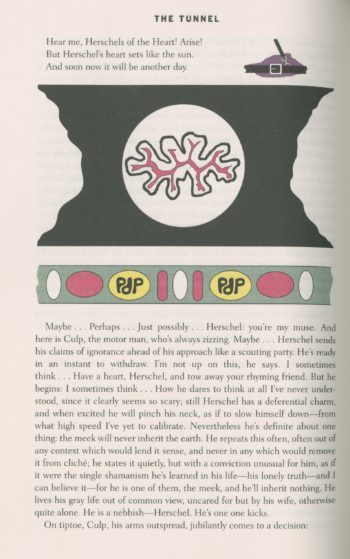
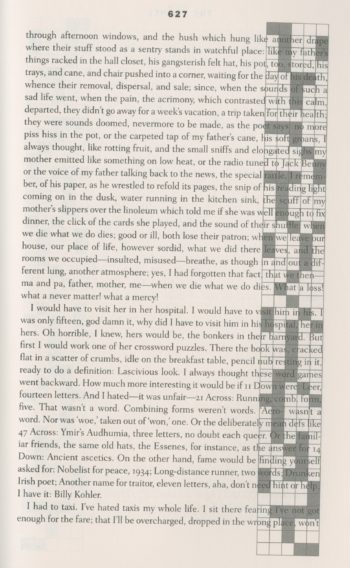
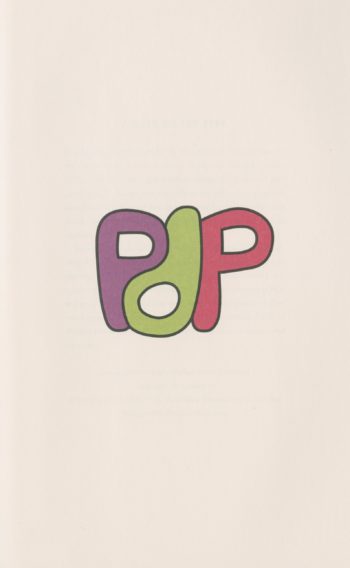
The William Gass Papers also include original drawings and artwork Gass created when conceiving the layout of the book, including a PdP armband, different possibilities for a PdP flag, a badge for “The Jaundiced Eye,” “The Passive Emotion Pennant,” and diagrams of the tunnel Kohler is supposedly digging, which coincide with the twelve philippics of the novel.

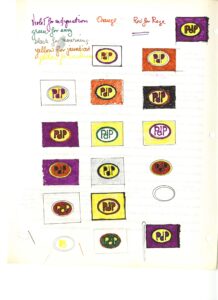
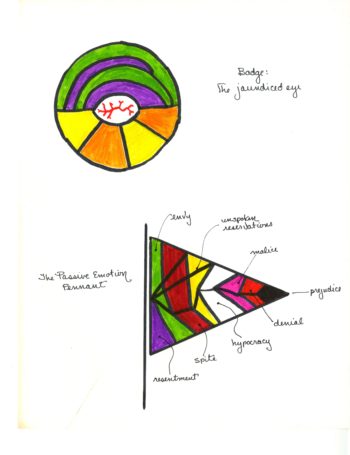
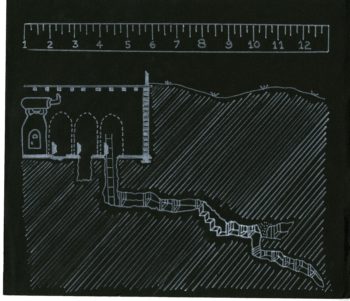

See the finding aid and our digital exhibition, The Soul Inside the Sentence, for more materials related to The Tunnel and other works by Gass. Or, stop by to see them in person tomorrow or any time Special Collections is open, Monday – Friday 9:00-5:00!


